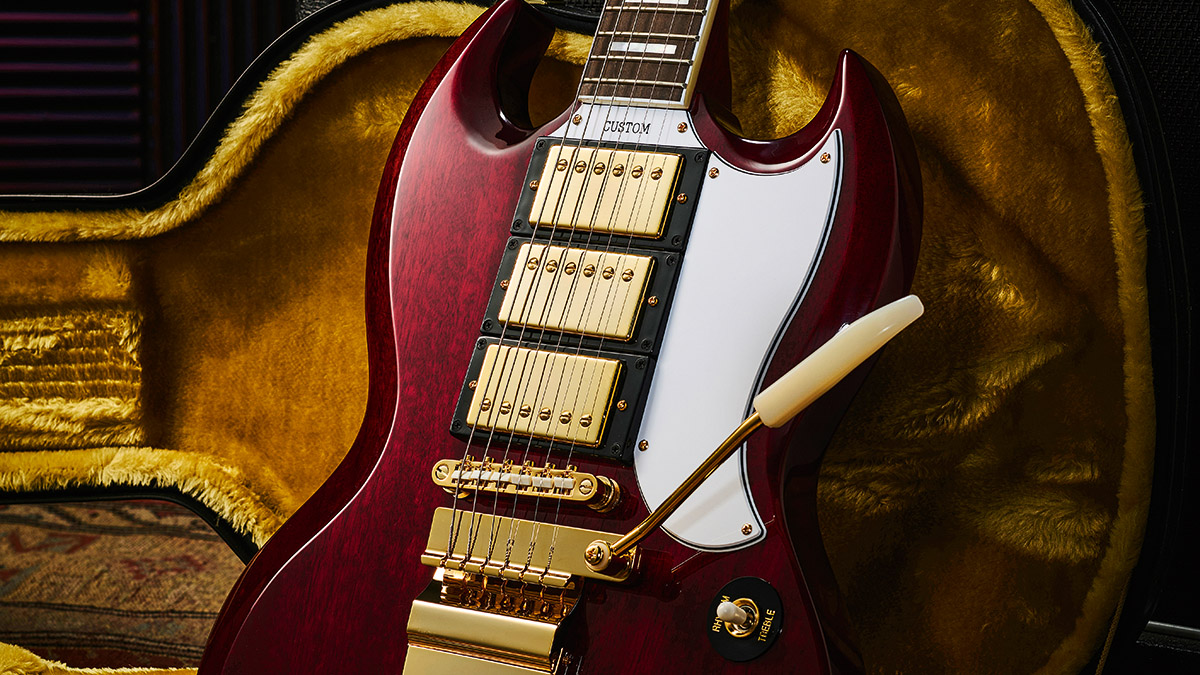
The first decent electric guitar that this reviewer put his pennies away each week for was a white SG Custom, inspired by Alice Cooper’s original guitarist Glen Buxton on the band’s rendition of Under My Wheels on The Old Grey Whistle Test. The SG never materialised, but that’s another story.
While Buxton’s Custom was the later 1966 to ’71 style with the large scratchplate, Joe Bonamassa’s own Gibson SG comes from the middle of the 1961 to ’66 era, with the small pickguard and ‘lyre’ engraved long Maestro Vibrola that appeared in ’63, just as the twin-cutaway Les Paul model changed its name to SG.
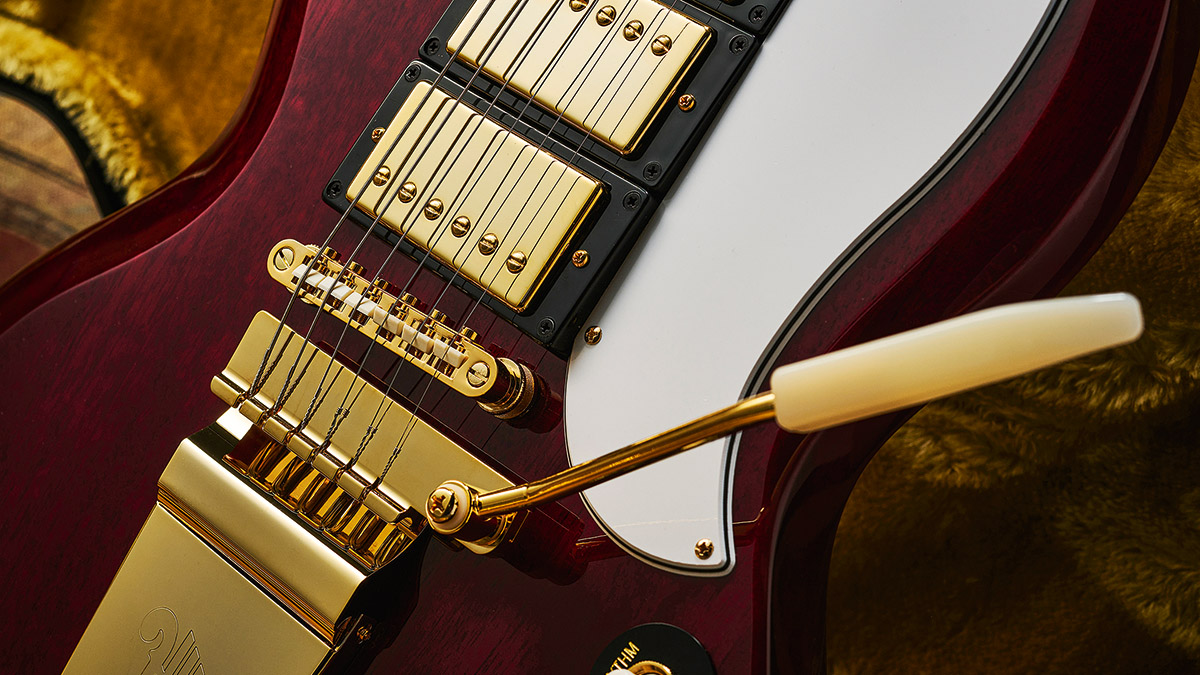
A faithful recreation of its Gibson forbear, our Epiphone features a two-piece mahogany body with chamfered edges and pincer-like horns, the lower a touch shorter than the upper. Into this is glued a one-piece, slim-taper mahogany neck topped by a single-bound, block-inlaid ebony fingerboard with 22 medium-fine frets.
Joe’s own ’63 Gibson has a relatively unusual neck join, where it tapers smoothly into the body without the usual step. Over the years, Gibson tried various methods to give this notoriously weak point greater structural integrity, and while one doesn’t see too many like this, it is a genuine Gibson appointment.
The Custom’s headstock is the short Epiphone design that suits it very well. The ‘split H’ pearl inlay is a bold statement, but the five-ply headstock binding is dark orangey yellow as opposed to the creamy white of the neck binding. Apparently, this is to reflect Joe’s own ’63, but it does look a little odd.
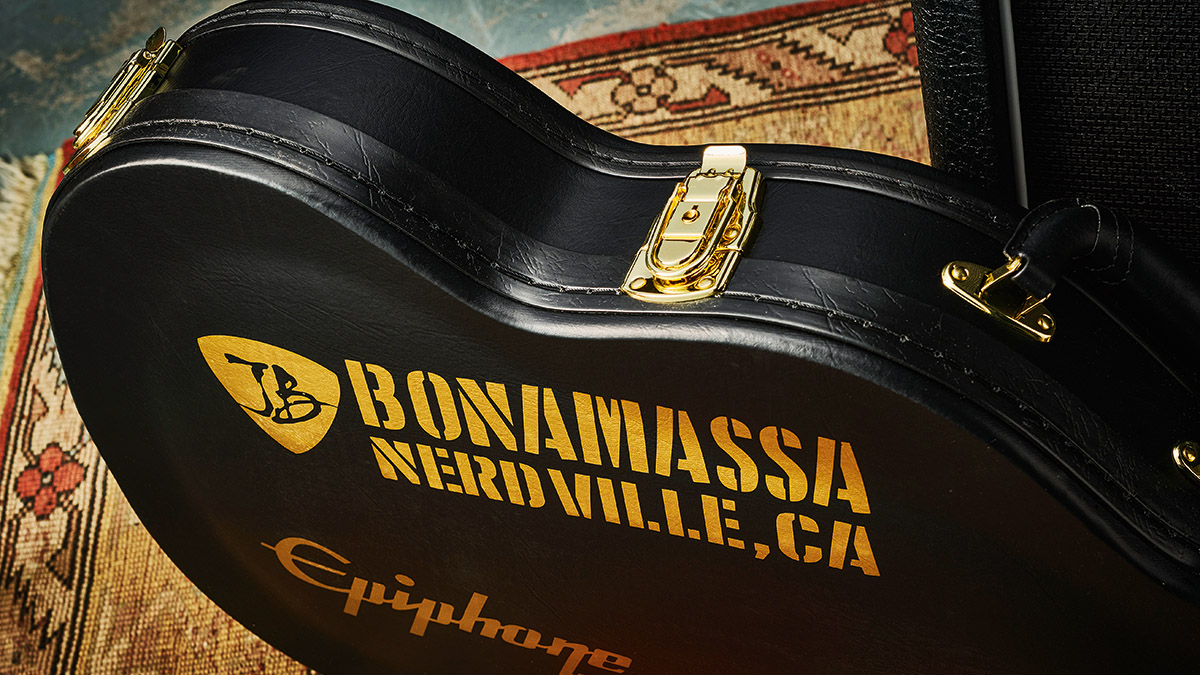
Powering the Custom are three Epiphone ProBucker pickups – a slightly higher-output 3 at the bridge and twin 2s in the neck and middle positions. ProBuckers are wax potted and feature nickel alloy covers and sand cast Alnico II magnets. Although made in China, their spec is very close to that of Gibson’s own pickups.
A nylon-saddle LockTone tune-o-matic style bridge and Epiphone-engraved ‘lyre’ style Vibrola tailpiece complete the picture. It’s all gold-plated, too, making this one of the most opulent guitars around (“Don’t even look!”).
Of the various switching options available on a three-humbucker guitar, which obviously include neck and middle pickup combined, or middle humbucker on its own, Epiphone instead opted for bridge and middle together, wired in parallel. Due to their close proximity, and the lighter tone that the SG’s construction naturally brings, far from being an odd choice this proves to be a masterstroke. More of which later.
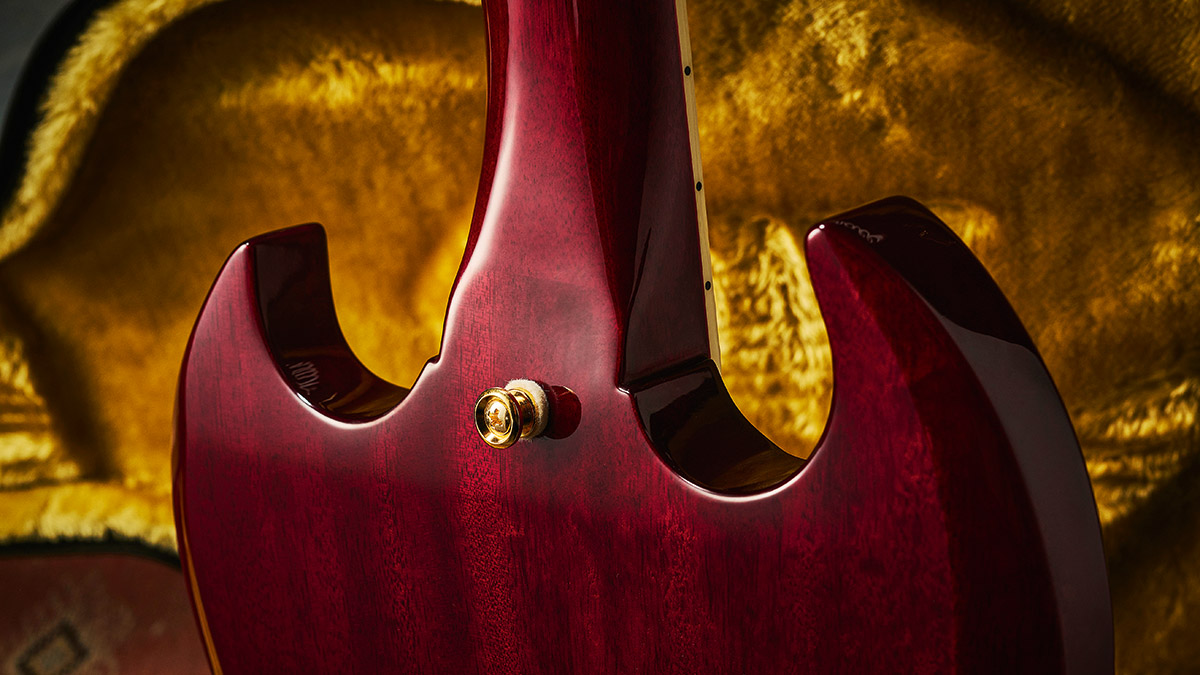
Although finished in ubiquitous Eastern Asian polyester, here the Chinese factory has done a brilliant job of making it not look thick and plasticky. It’s smooth, glossy and, to be honest, we didn’t think twice about it being nitro or not.
The mahogany grain shines through the dark Wine Red stain, really complementing the white pickguard and matching ‘Custom’ plate, sited between neck pickup and fingerboard to hide the otherwise visible neck tenon.
Overall, we reckon Epiphone, with serious input from Joe, has done a cracking job of putting this guitar together.
Feel & Sounds
Some guitarists find it troublesome adjusting to how an SG’s neck protrudes from the body the way it does. Others don’t get on with a middle pickup – for example, Ritchie Blackmore lowers his Strat’s second single coil pickup as he feels it gets in the way.
Other players simply find big, bulky vibrato systems too intrusive, especially when they lend only a mild wobble to chords or melodies. Put all three together and you can see how an SG Custom might be a bit of a challenge to some guitarists.
However, a little time spent adjusting to all three and one quickly finds a guitar like this immensely rewarding. In truth, unless you’re a real digger-inner, the centre humbucker shouldn’t be a problem.
Switching from, say, a Strat to a PRS, everyone knows that there’s some reconfiguring of how you pick and wobble. And by the time you’ve overcome these issues you’ve probably forgotten that your SG’s 15th fret is where the 12th usually is!
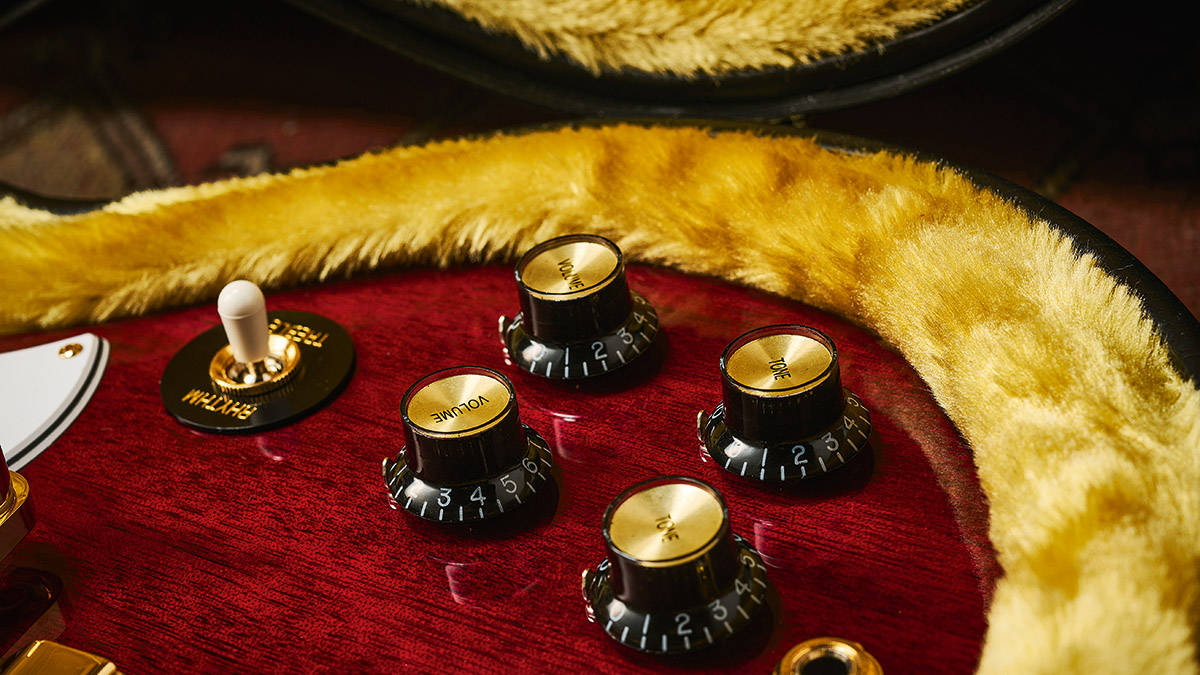
Speaking of frets, on our Custom they’re medium verging on fine, but with the guitar’s smooth ebony ’board, 304mm (12-inch) radius and slinky neck, bends and vibrato are not an issue. And with that totally free expanse of pearl-inlaid ebony laid before you, the fretboard is a playground for exploration – even at its highest reaches, especially with this neck’s smooth transition into the body.
Plugging into our ever-faithful Laney Lionheart 20, we are reminded how satisfying the clean clank of an SG can be. The body’s relatively light mass and delicate build give it a vibrancy that you just don’t get from a Les Paul. The bridge pickup is strong and strident, while the neck is either Les Paul lite or fat Strat, depending on how you view it. With the selector in the middle we find some very interesting tones.
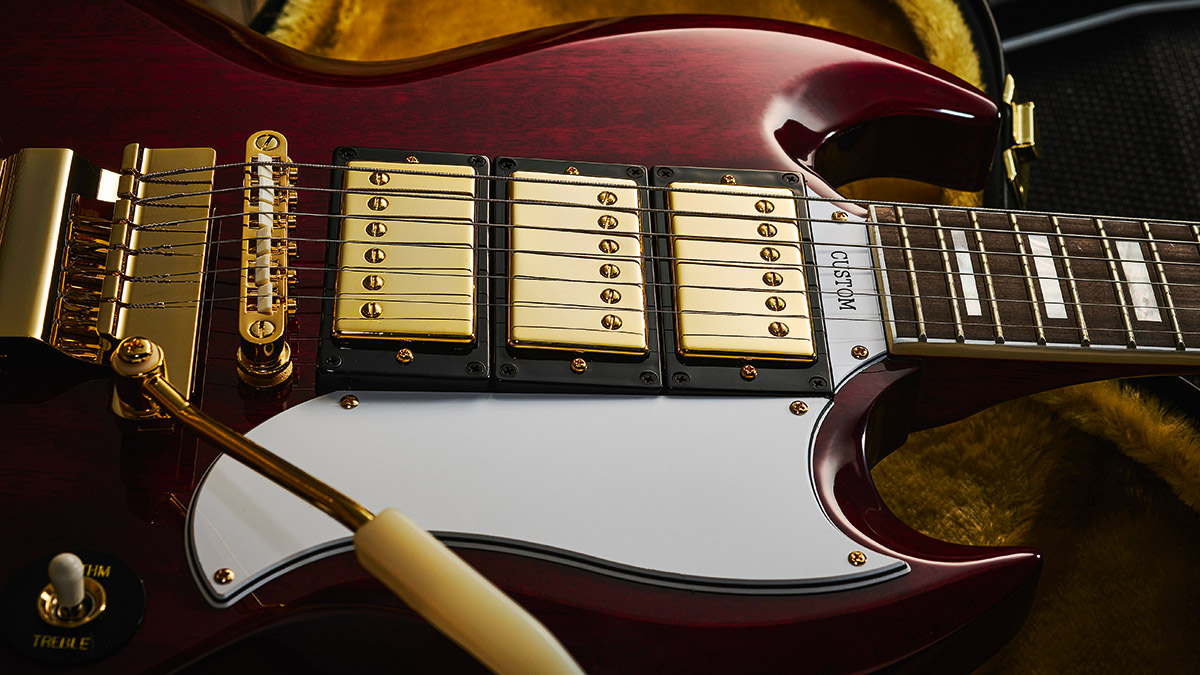
Rather like a Strat’s positions 2 and 4 on the blade switch, the proximity of neck and bridge humbucker to each other makes for a tone that’s pleasantly vowelly, a little bit Strat-ish, and you could find a use for it in a host of funky rhythm, picked arpeggio and straight strumming scenarios. While you could be forgiven for thinking they are out of phase, Joe tells us they are not.
Whack up the Laney’s wick and ‘both pickups on’ is Glen Buxton’s Under My Wheels tone. Flip to the bridge and it’s instant Angus Young, or The Doors’ Robby Krieger if you back off slightly. Go to the neck and it’s hard not to rush straight for the Sunshine Of Your Love riff – indeed, Clapton nicknamed his SG ‘Sunny’ after the song.
And when you consider how much you can do with twin volume and tone controls, you’ll see there’s a ton of great sounds here, certainly more than on most Gibson-type guitars.
Verdict
The elephant in the room is, of course, the Custom’s price. But while $/£1,499 seems a lot when compared with other Epiphones, and especially when you can find Gibson’s own SG Standard for a similar price online, there really is a lot of guitar here.
Materials are all fine quality, including the real ebony fingerboard with genuine mother-of-pearl inlays, top-notch parts such as Kluson ‘waffleback’ tuners, a proper Vibrola, and three of Epiphone’s excellent ProBuckers with CTS pots and Mallory capacitors.
It comes in a classy hardshell guitar case with ‘Bonamassa, Nerdville, CA’ stencilled on the top, and, of course, we can’t forget the input from the man himself, a player we know is fastidious about how his guitars look, play and sound.
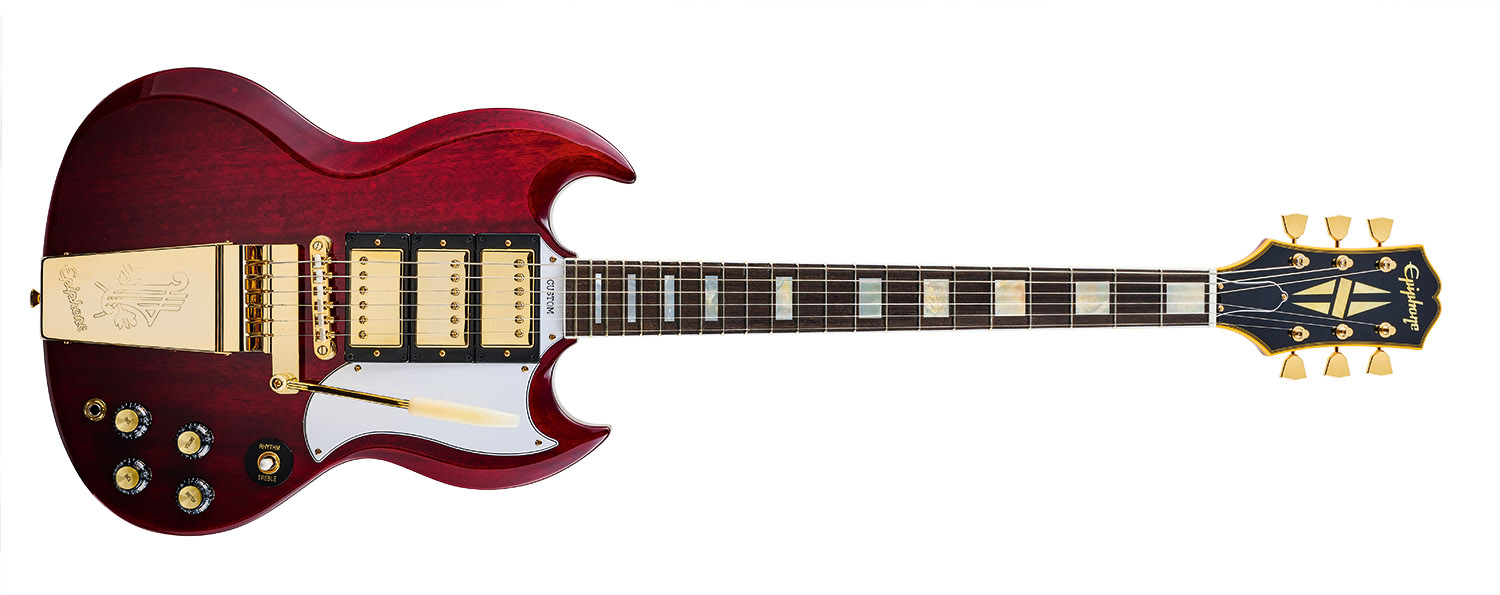
It’s true that SGs divide opinion, as do three-humbucker guitars in general and big, bulky vibrato systems. But whatever your view on it, and whether or not you think the price is on the high side, we have to concede that between them Epiphone and Bonamassa have created a stunning-looking guitar that not only makes a powerful visual statement but which also covers pretty much any musical base you can think of.
So while you might not think so at first sight, this is a very versatile guitar indeed. If you’re yet to be converted to the joys of the SG experience, we think this could well do it.
Specs
- PRICE: $/£1,499 (inc plush ‘goldenrod’ lined case with Epiphone and Joe Bonamassa graphics)
- ORIGIN: China
- TYPE: Double-cutaway, solidbody electric
- BODY: 2-piece mahogany with chamfered edges
- NECK: 1-piece slim-taper mahogany with unusual smooth neck to body joint, glued-in
- SCALE LENGTH: 629mm (24.75”)
- NUT/WIDTH: Graph Tech/43.022mm
- FINGERBOARD: Single-bound ebony, mother of pearl block inlays, 305mm (12”) radius
- FRETS: 22, medium jumbo
- HARDWARE: Epiphone LockTone tune-o-matic bridge and Maestro Vibrola vibrato/tailpiece, Kluson waffleback tuners w/ ‘tulip’ buttons – gold plated
- STRING SPACING, BRIDGE: 51.5mm
- ELECTRICS: 2 covered Epiphone ProBuckers (neck and middle), covered Epiphone ProBucker 3 (bridge), 3-way toggle pickup selector switch, volume and tone for each pickup
- WEIGHT (kg/lb): 3.54/7.8
- OPTIONS: None
- RANGE OPTIONS: None
- LEFT-HANDERS: No
- FINISHES: Gloss dark Wine Red polyester
- CONTACT: Epiphone







